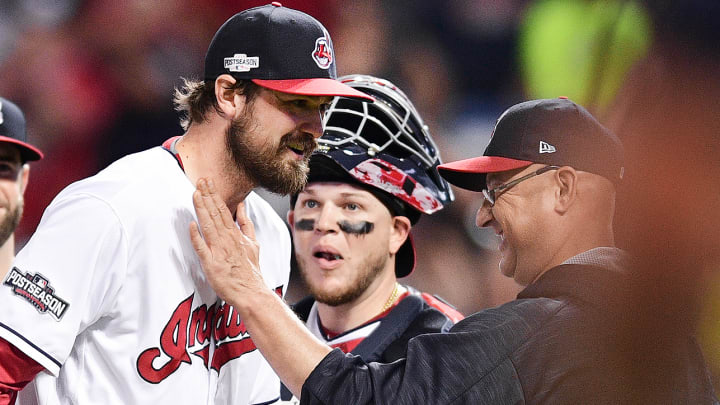Indians’ Andrew Miller gamble pays off in ALDS Game 1 win over Red Sox

It was a home run derby in Cleveland as the Indians hit three (all in the third inning) and the Red Sox added three more. It all added up to a 5–4 Indians win in Game 1 of the ALDS on Thursday night. Trevor Bauer went 4.2 innings and allowed three runs for the Indians, and Jason Kipnis went 3-for-4 with a homer. Rick Porcello allowed five runs in 4.1 innings and Hanley Ramirez went 2-for-4 with an RBI for the Red Sox. Game 2 is Friday afternoon.
Porcello’s poor start
Rick Porcello has allowed at least one home run in his 17 of his 33 starts this season. That he finished 22–4 with a 3.15 ERA speaks to his ability to limit the damage. On Thursday, that damage came fast and early. Roberto Perez hit the first; followed by back-to-back blasts by Jason Kipnis and Francisco Lindor. It’s the first time Porcello has given up four or more runs in a start since July 24 and he didn’t get past the fifth inning. Porcello, not David Price, has been the Red Sox ace this season. Four runs is about the limit of what he should give up and not have to worry, given the Red Sox offensive prowess. In fact, if the Red Sox starting staff can give up around four runs a game throughout the playoffs, they have a good chance of a deep run. There are few, if any, pitching staffs that can slow down the Red Sox offense. But given the bullpen’s struggles, Porcello is going to have to go deeper than the 4.1 innings he threw in Game 1. Of the regular relievers on the ALDS roster, only Brad Ziegler has an ERA less than three. Going to Drew Pomeranz with a runner on second in the bottom of the fifth is less than ideal—especially when he promptly allows that runner to score.
Division Series predictions by MLB experts at Sports Illustrated and Fox Sports
Francona’s gamble pays off
The decision to bring in Andrew Miller in the fifth inning was both unusual and smart. On the one hand, bringing in Miller that early could backfire, especially in the eighth and ninth innings. On the other, the Indians needed to keep the Red Sox at three runs and who better than their best pitcher? But with two outs in the fifth and no one on? It was an interesting decision by Terry Francona, which was promptly greeted by a Brock Holt double and a Mookie Betts walk. Miller then rallied to strike out Mr. Clutch, David Ortiz en route to two innings with no runs and four strikeouts. How much Francona uses his best player—a 1.55 ERA in 29 innings— will be something to watch the rest of the series. He’s clearly not going to use him only in the ninth, and hasn’t done that all year. The bigger question is: how many innings can Miller pitch in a five-game series? Miller threw 40 pitches Thursday night. Cody Allen, the closer, threw 40. If they’re both able to go multiple innings each game, then the Indians starters will only have to go five innings—Miller for two, Allen (2.51 ERA) for two. When Miller enters will be based on the situation, not the inning—a trend to keep an eye on next season.
2016 MLB playoff flowchart: Which team should you be rooting for?
Boston bottom of the lineup produces
The most dangerous part about the Red Sox is their offense. They’re even more dangerous when they get the bottom hitters to contribute. The Sox had three home runs from Andrew Benintendi (who became the youngest Boston player ever to hit a playoff homer), Sandy Leon and Brock Holt. Benintendi’s third-inning blast was in his first postseason at-bat. Leon and Benintendi combined for three hits, two runs and two RBIs from the 8–9 holes respectively. Even though they lost, the more contributions from the bottom of the order, the less the Red Sox will need from their stars. The Sox had the fourth highest-scoring offense in baseball, but only the third highest in the AL playoffs. If they can get Holt, who batted second, and the bottom of the lineup to contribute consistently alongside their stars, they might be hard to top.
